Farm Machine, Tractor
20 Types Of Farm Equipment With Pictures (AND Their Uses)
If you are a new farmer, you may know the most common farm tools but you might find it challenging to understand all the different types of farm implements.
There are common farm tools like shovels and tractors but there are also soil cultivation equipment and quite a few different tractor attachments.
You may not need them all, but we have listed below 20 unique types of farm equipment to help you determine the items you may need for your farming operations.
*This post may have affiliate links, which means I may receive commissions if you choose to purchase through links I provide (at no extra cost to you). As an Amazon Associate I earn from qualifying purchases. Please read my disclaimer for additional details.
List of Farm Equipment with Pictures & Their Uses
Modern farmers need a wide variety of equipment for their farming jobs to have successful seasons, from soil cultivation equipment to seed drills, tractor-pulled transplanters, and even utility vehicles.
However, since budgeting is a big problem for new farmers, we only list the essential ones that you should have on your farm from the get-go.
1. Tractors
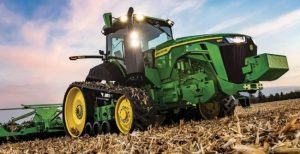
Tractors are the most popular farm machinery and they come in many sizes for all your farming operations.
The primary purpose of a tractor is to pull farm equipment, but you can couple your tractor with a wide variety of attachments for nearly all your farming demands.
There are four types of tractors on the market:
- Compact tractors: This small and high-powered tractor type can handle all the basic functions of a tractor AND is often used in small spaces that traditional tractors cannot reach.
- Wheeled tractors: These tractors can do almost all farming jobs, like handling heavy materials and equipment, tilling the soil before sodding, transportation, etc.When picking up a wheeled tractor, you should consider its horsepower and its coverage area so you can get the most use out of these tractors.
- Track tractors: A track tractor is used to plow the area with little slippage and rutting AND can perform challenging tasks while also providing a smoother ride on rough fields.
- Orchard tractors: As its name, an orchard tractor is primarily used in orchard fields and performs landscaping tasks and farm maintenance while not affecting the trees.
Read More: How to Drive a Tractor Video and beginner’s guide.
If you are just starting out, discover safety rules and statistics surrounding tractor operation, how to get to know your machine, and watch a helpful video.
2. Harvesters
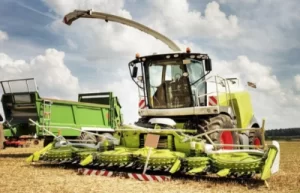
Harvesters (or Combine Harvester) are agricultural machinery that is used in all farm sizes to cut and collect crops with less manual labor.
This harvesting equipment comprises 21 parts, including rotating blades, belts, augers, wheels, and much more.
All of these parts work together to help you harvest in three processes – reaping, threshing, and winnowing – but you can choose a harvester or tractor attachments depending on your farm’s demands.
Additionally, many modern harvesters can also track crop data, providing information on the areas that need to improve in the upcoming year of crop production.
A harvester is a serious investment in this list of farm equipment, but a good quality harvester will bring you greater output and returns with less effort.
3. ATV/UTV
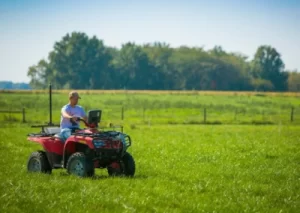
ATVs and UTVs are two popular types of wheeled utility vehicles and two types of farm equipment that differ in price, size, and features.
ATVs (all-terrain vehicles), also called quad or four-wheelers.
While ATVs are cheaper and smaller than UTVs, they have only one seat available for a single driver.
Because of their small size, an ATV can fit into tight spaces and do quick turns to do simple farming tasks that larger farm equipment cannot attempt.
UTVs (utility task vehicles), or side-to-side (SxS) vehicles, are bigger, far more expensive, and more powerful than ATVs but come with extra features for tackling challenging tasks.
This beefy farming vehicle can be controlled by two people and can handle heavy loads.
Due to its big size, this vehicle allows you to have extra storage space for your farming machinery or personal belongings.
Additionally, driving a UTV is also safer thanks to its safety features, like seatbelts, a windshield, and a roll cage.
Some premium UTVs also offer you advanced features, like power steering, lighting, or four-wheel independent suspension.
4. Balers
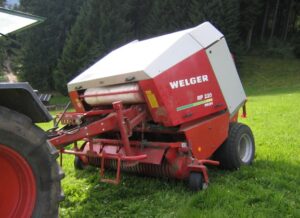
Balers (or Hay baler) make collecting materials less arduous for farmers as they collect and compress raked crops like hay, flax straw, silage, or corn stalks.
Balers turn these materials into compact bales that are easier to store, move, and handle.
There are four types of balers depending on the bale’s shape and size, including round balers, square balers, rectangular balers, and large square balers (or industrial balers).
Round balers are the most common baler type and are often seen on large farms.
A round bale weighs from 1100 to 2200 pounds and is easier to roll out than a square bale.
However, round balers are more expensive than square balers.
Rectangular and square balers are better at space-saving due to their bale shape, but surprisingly, square balers are less popular than rectangular balers since they are less efficient at large-scale farming operations.
5. Plows
Plows (or Plough) are the most critical agricultural equipment in this list of farm equipment.
A plow is most often a tractor attachment that loosens and turns the first soil layer to let soil receive fresh air and new nutrients, preparing it for the next crop.
The act of plowing also helps remove unwanted vegetation on the surface.
When the soil is well-plowed and free of weeds and dead vegetation, it will be ready for sow seedling or plantation.
Depending on your soil condition, soil type, and crop type, you can choose one or a combination of plows for your farm. Below are the three most popular plow types:
Moldboard plow
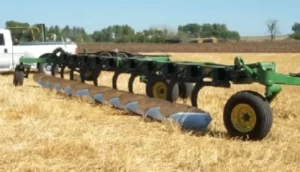
This plow type is used on lands that have not been used for plantation for a long time and uses wing-shaped blades to cut and turn the hard soil thoroughly.
Chisel plow
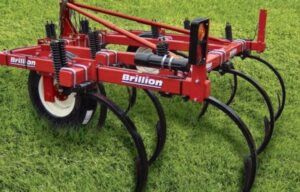
A chisel plow is great to use for land that is consistently used for crop production and comes with long shanks to dig down to 12 inches in depth.
Chisel plows are used for removing soil but still leave some crop residue on the top surface and do not leave a smooth seedbed for plantation.
Hence, you need to take further steps in soil preparation after using this plow type.
Disk plow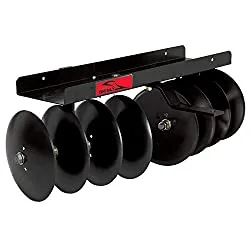

Disk plows are less popular and less effective at turning the soil than moldboard plows.
This plow type uses rows of metal disks to turn the soil and cut unwanted vegetation and is often used in sticky or rocky soils.
6. Harrows
Harrows are crucial to properly maintaining healthy fields among these farm tools and equipment.
A harrow, a type of pull-behind mower, is one of many different types of tractor attachments but is often attached behind an ATV or a tractor to blow up and smooth out the soil surface, evenly distribute the crop residue, and postpone the growth of weeds.
There are four main types of harrow:
Disc harrow
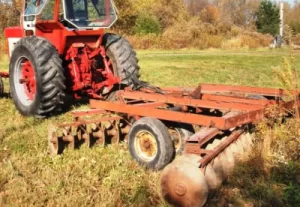
A disc harrow comprises a row of metal discs that chop up weeds or crop residues. This harrow type is more powerful than spring or tine harrows.
Tine harrow
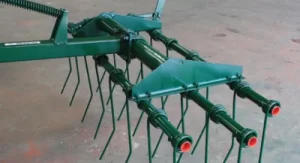
A tine harrow is often used for light-duty jobs, like soil preparation for seeding.
This harrow is also good at removing weeds, weed control, or smoothing out the top layer of the soil, thus allowing the soil to absorb water easily.
Spring harrow
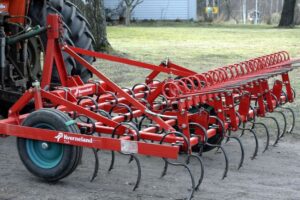
This harrow type is not too popular today but this harrowing attachment uses rows of iron teeth to loosen up the soil.
Chain harrow
A chain harrow can be used for various applications depending on the chain’s weight.
Lighter chain harrows work like tine harrows, smoothing out the soil for sowing seeds, while heavier chain harrows help remove clods of earth from the surface.
7. Fertilizer Spreaders
Fertilizer spreaders help you achieve distribution jobs faster and more consistently than hand seeding.
You can use this farm equipment to apply any farm treatments, from fertilizers to grass seeds, insecticides, fungicides, or plant seeds.
There are two types of fertilizer spreaders – Drop and Broadcast.
Drop Spreaders
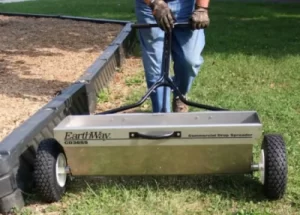
Drop spreaders have high accuracy as they spread seeds onto specific areas.
This spreader type works best for lawns and gardens under 5,000 square feet, but it is easy to control and navigate through obstacles.
Broadcast spreaders (Or Rotary spreaders)
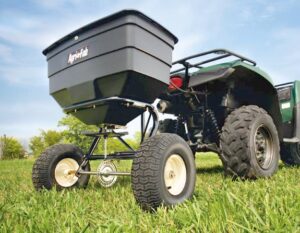
Broadcast spreaders (or Rotary spreaders) are more time and cost-efficient than drop spreaders, especially for large-scale farms.
Thanks to its big hopper capacity, this spreader distributes seeds and fertilizers in a shorter time with fewer refills.
This spreader also comes with advanced features that better serve high-demanding application tasks.
It is a good investment so you should pick up a fertilizer spreader that best fits your budget and farm size.
Fertilizer spreaders are also available as attachments for ATVs/UTVs and tractors. So, if you have had these farm vehicles, it could be a strong advantage.
8. Seeders
Seeders help you distribute seeds more evenly and quickly than small mechanical seeders or hand-seeding methods.
This tractor attachment is widely used on large farms and comes in four different types of seeders that are used in agricultural seeding.
Broadcast Seeder (known as Rotary Seeder)

Broadcast seeders are available in all sizes, from compact ones that you can carry on your neck to heavy commercial ones behind a large tractor.
The seeds are stored in the hopper, and they will be placed in an area when a plate turns before depositing the seeds.
Air seeder
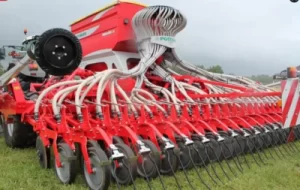
An air spreader uses the air compressor to shoot seeds into the ground and is used for applying small and round seeds.
Box drill seeder
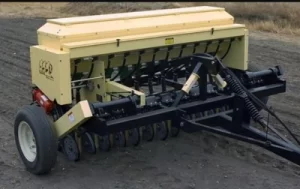
Box drill seeders are easy to use, digging and planting seeds into the soil at a certain depth, AND can work with almost all seed types.
Planters
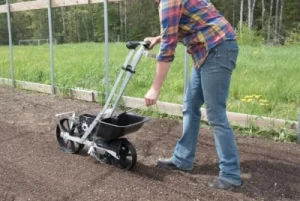
A planter works by digging into the ground, placing seeds, then closing the ground immediately.
Planters are the most accurate but also the most expensive seeder type.
9. Transplanter
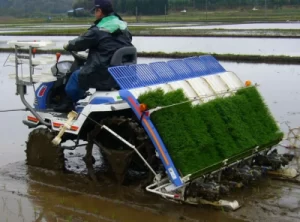
Transplanters have long been used as a tractor attachment on large-scale farms of 10 acres or more.
Tractor-pulled transplanters simplify your transplanting job by transporting a high number of growing plants, placing them in holes, and then depositing them.
If you are a small farm owner, you can use a hand transplanter to place plants in the ground without crawling.
10. Sprayers
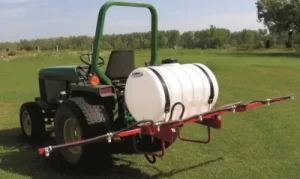
Sprayers are widely used in agriculture to spray liquids like water, pesticides, herbicides, compost tea, etc.
You can use this farm tool to water your plants or control weeds, insects, and diseases to give your farm a healthy development.
The choice of sprayer depends on your farm size.
Backpack-sized sprayers and walk-behind sprayers are hand-operated and suit small-scale farmers well.
On the other side, a tractor- or ATV-mounted sprayer is appropriate for medium to large-sized farms.
11. Trailers/Wagons
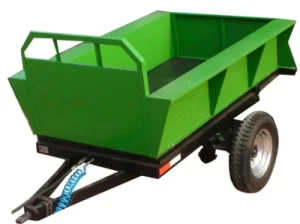
Farm wagons (or farm trailers) are versatile two- or four-wheeled wagons for your daily farm operations.
These heavy-duty vehicles can assist you in many purposes, like transporting heavy agricultural equipment and materials, harvesting goods, acting as a transporter for employees and visitors on a big farm, etc.
Like other farm machinery, wagons and trailers are available in different sizes, features, and prices.
Your tractor can tow small trailers or basic carts (or small wagons).
These basic carts are affordable and good to use for backyards or small farms. Tow-behind trailers are also heavy-duty and can tackle more challenging jobs.
12. Plastic Mulch Layer
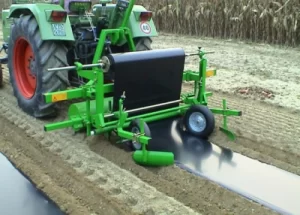
Plastic mulches are often applied on farms involving plasticulture growing methods.
A plastic mulch layer is attached to a tractor to control weed growth and conserve moisture in hot weather conditions.
Mulches also help keep methyl bromide – an ozone and fumigant depleter – in the soil.
Plastic mulches also act as a protective layer to prevent crops from extreme weather conditions.
However, this plastic mulch layer is not very environmentally friendly as the disposal of single-use plastic mulches can result in harmful effects on soil ecologies.
13. Mowers
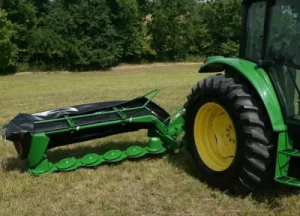
A mower is a piece of invaluable farm equipment designed for cutting grasses, hay, and harvesting crops.
Mowers use a cutter bar to cut the stems of standing vegetation at 3-10 cm above the ground to make hay.
As a farmer, at the very least, you need a mower in your farm equipment collection.
There are many mower types, including push-behind mowers, zero-turn mowers, rotary mowers, brush mowers, and so on.
In terms of power options, mowers can be divided into three groups – electric, cordless, and gas-powered mowers.
Gas-powered mowers are powerful and the most expensive, while electric mowers are the most compact and cheapest ones for starters or small landowners.
When picking up a mower, you should consider your farm size, land type, cut quality, extra features, and budget.
14. Rakes
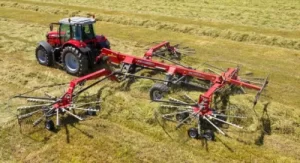
If your farm involves making hay, rakes are must-have equipment.
A rake is a handy tool that is often attached behind a tractor using a three-point hitch.
A rake for a sub-compact tractor has a minimum width of 4 feet, while a rake for a compact or big tractor can be up to 10 feet.
Picking up wheel rakes, parallel-bar rakes, or rotary rakes depends on the hay-cutting job demand, the moisture of the hay, and the available storage area on your farm.
15. Backhoe Loader
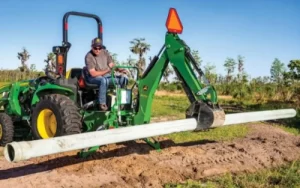
A backhoe loader (or called Loader backhoe) looks like a tractor, but it has a shovel or bucket on the front and a backhoe behind.
In agriculture, a backhoe loader takes part in landscaping jobs of all levels.
It can dig and move trees to a new location or carry heavy materials like dirt, rocks, and dead vegetation.
You can also use this farm vehicle to dig small ponds or fence post holes for fence installation.
If your farm operations often involve digging holes or lifting heavy loads regularly, you should purchase a backhoe attachment for your tractor.
For commercial farming jobs, an industrial backhoe standalone should be more than powerful enough to tackle the jobs.
16. Milking Machine

A milking machine is used to automatically take milk from cows and goats on commercial dairy farms and is essential for dairy farms.
This equipment allows all cows to be milked the same way every day, which is more comfortable and healthier for them than hand-milking while also ensuring high milk quality, cleanliness, and quantity.
17. Machete
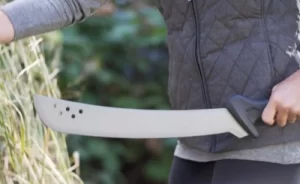
A machete looks like both an ax and a sharp knife.
Once a deadly weapon, a machete is now used in agriculture for various purposes, like clearing brush and weed control in lawns, chopping compost into small pieces for a quick breakdown, harvesting crops, and more.
However, this razor-sharp hand tool can be dangerous if you are not familiar with it.
When working with this tool, you should wear work boots, long pants, and work gloves to protect yourself from injuries.
And remember to always put this weapon out of the reach of children and pets.
Read our related article on the Best Machetes for Clearing Brush where we put the top machetes to the test and rank them on their performance!
18. Shovel
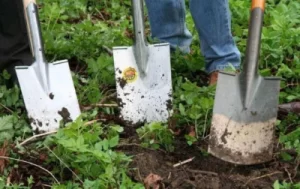
A shovel is an essential gardening and farming tool, consisting of a broad bowl-shaped blade with a round/pointed tip and a long shaft.
In farming, a shovel is used to dig and move small piles of materials from one place to another.
There are many types of shovels to serve specific purposes, and they differ from each other in their blade shapes.
You should pick up one or several shovels that suit your work demands, including scoop shovels, flat shovels, digging shovels, trench shovels, and tree planting shovels.
19. Farm Truck
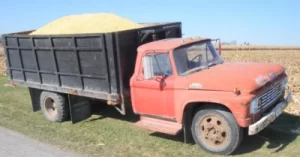
A farm truck is specifically designed for agricultural use and is intended to work ON the farm, making your jobs more efficient and easier.
You can use this farm vehicle for countless purposes, like moving heavy farm equipment, transporting hay to another place, carrying tools and supplies around your farm, etc.
A heavy-duty truck is a reliable part of your farm operations.
Unlike personal trucks, this farm vehicle can work in harsh weather conditions, helping you maintain your daily farm chores even on rainy, muddy, and even snowy days.
You can pick up an appropriate farm truck size, from small, mid-sized, to full-size.
20. Irrigation System
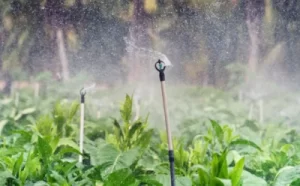
An irrigation system (also known as an irrigation sprinkler) is vital to keep your plants well-hydrated in areas where rainfall is unbalanced or in dry seasons.
Compared to rain-fed agriculture or manual watering, an irrigation system is more efficient in cost and time.
Besides, this artificial water distribution also consistently waters your lawn and landscaping, so all parts of your lawn will always be good-looking and healthy.
Depending on water distribution, there are several common irrigation systems, including surface irrigation, localized irrigation, drip irrigation, sprinkler irrigation, and lateral move irrigation.
FAQ Section
What is the most common farm equipment?
The most common farm equipment for any farm includes a farm truck, a tractor, a mower, shovels, post-hole diggers, and irrigation systems.
What type of equipment do farmers use to plant?
For farms that are growing crops, farmers utilize tractors with attachments that can be used for soil cultivation such as a tiller, a harrow, and a plow to plant crops.
Planters and transplanters are also common farm implements for planting crops as well as an irrigation sprinkler to keep your crops well-hydrated.
What machines are used to harvest?
Harvesting equipment can vary widely depending on the type of crop you have planted and are harvesting.
But the machines used to harvest include combine harvesters, reapers, and mowers.
Final Words
Unless you have prior experience in farming and agricultural work, it might be challenging to make your list of farm equipment.
After reading this article with farm equipment pictures and names and uses, I hope you have had some clues to create your wishlist of what you need for your farm, estimate your budget, and start shopping.

